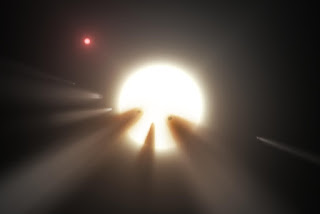 |
| Credit: NASA/JPL-Caltech |
Topics: Astrophysics, Dyson Sphere, Exoplanets, Kardashev Scale, Kepler Telescope, SETI
It's looking less likely that a swarm of comets or an "alien megastructure" can explain a faraway star's strange dimming.
The star (nicknamed "Tabby's Star," after its discoverer, Tabetha Boyajian) made major headlines last October when Jason Wright, an astronomer at Pennsylvania State University, suggested that it could be surrounded by some type of alien megastructure. A more likely idea — one that's far less exciting — is that the star is orbited by a swarm of comets. But scientists can't be sure either way.
The first signs of the star's oddity came from NASA's planet-hunting Kepler space telescope, which continually monitored the star (as well as 100,000 others) between 2009 and 2013. Astronomers, citizen scientists and computers could then search for regular dips in a star's light — a sign that an exoplanet has passed in front of that star. The largest planets might block 1 percent of a star's light, but Tabby's star dropped by as much as 20 percent in brightness. That, in and of itself, would be weird. But the periodic dimmings didn't occur at regular time intervals, either — they were sporadic. The signature couldn't be caused by a planet, scientists said.
Scientific American:
Comets May Not Explain "Alien Megastructure" Star's Strange Flickering after All
Shannon Hall, Space.com
#P4TC: Needle In A Haystack...
Comments